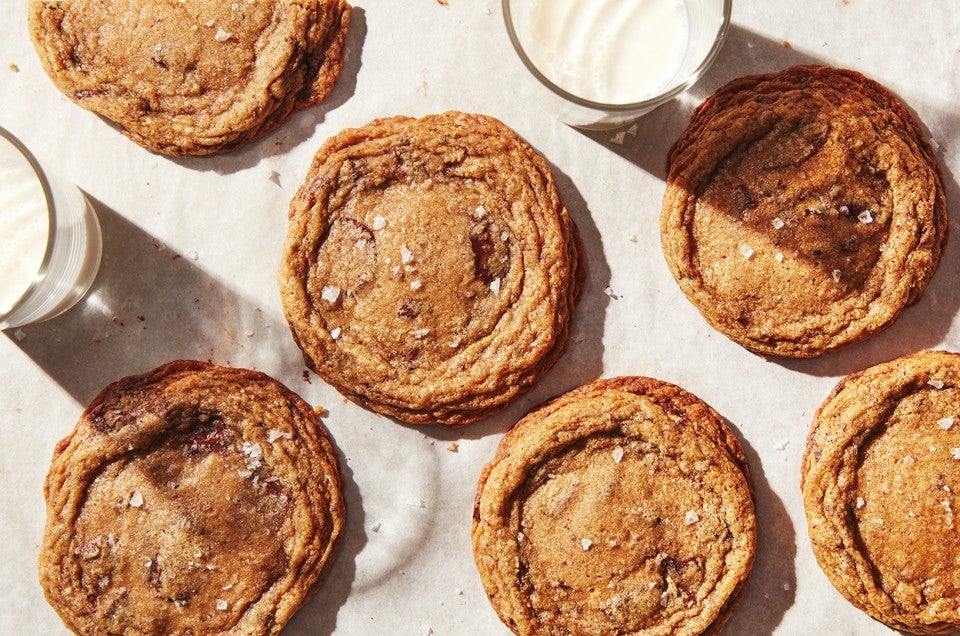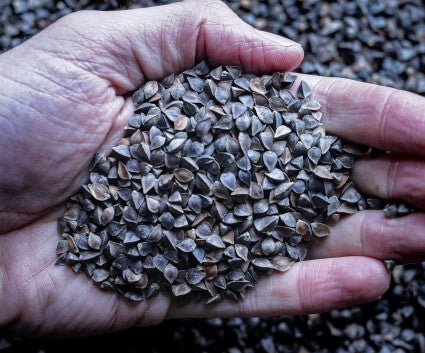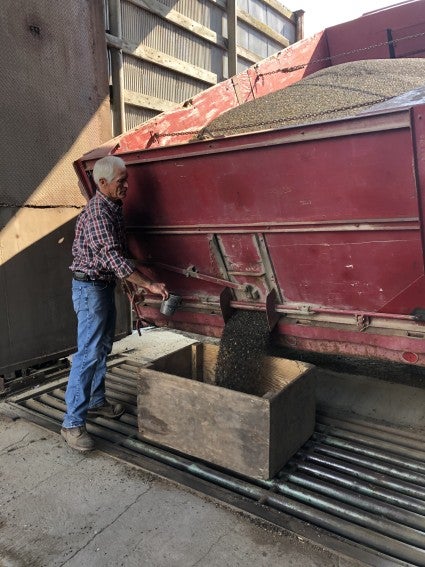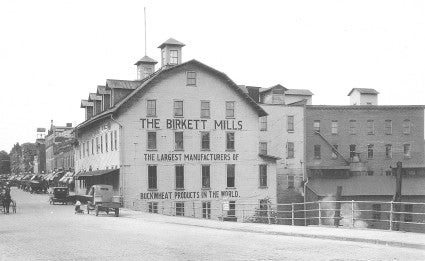Buckwheat, a small grain with a big impact
Can a cookie bake a difference? With buckwheat, the answer just might be yes.


I don’t brake for cookies. I’ll travel cross-country for a croissant or take a plane for a pizza, but I won’t get off the couch for a cookie unless it's seriously special.
Recently I found that cookie. Crispy edges, melty center, chunks of dark chocolate cloaked in the fragrance of browned butter and cardamom: this is the one. And my excitement goes beyond what’s on the tray. The bigger story here is a special ingredient, one that's both a baking and an environmental powerhouse.
Buckwheat, named for its triangular seed that resembles that of the beech tree (“boec,” meaning beech in Dutch became “buck” in modern English), is a fruit, or pseudo-cereal. Though it’s often treated like a grain, it’s not technically a grain like wheat or rye; instead, it’s related to rhubarb and knotweed and is gluten-free. (Yes, the name is confusing.)
Native to Asia and one of the oldest cultivated crops, buckwheat traveled westward across Eastern Europe to France. Most of what we see on our tables today takes one of four primary forms: flour (used for everything from bread to brownies, blini, pancakes, and French galettes), groats (the hulled seeds), kasha (the hulled seeds, toasted), and noodles (predominantly soba from Japan but also other versions in Italy).
At the height of the American buckwheat boom in the 1860s, over 1 million acres were planted. Nothing could beat buckwheat’s ability to grow quickly in unimproved soil (maturing to harvest in 90 days, much quicker than wheat at over 200 days) and feed people. With more nutritional value than traditional grains, it was unrivaled as a fast “pioneer crop.” “Buckwheat is one tough customer,” says Klaas Martens, a third-generation farmer in Penn Yan, New York. “You can throw it in dust and it’ll sprout.”

I asked Klaas about the decline of buckwheat acreage from its high point in the 1860s to a low of only 50,000 acres in the 1960s. Klaas links the reduction in acreage to the use of chemical fertilizers. “The balance [of nutrients] in the soil is something that farmers picked up intuitively over the years but were ‘freed from’ when we started inventing synthetic fertilizers and pesticides,” he explains. “[The fertilizers and pesticides] allowed us to plant whatever we wanted or made the most money on.” Klaas knows about this firsthand. He originally worked his land conventionally, but he ultimately experienced negative health effects that he related to the use of chemical herbicides on his fields.
There had to be a better way. “How did farmers do this before we had these products?” he thought. Searching for the root of previous best practices, Klaas found his way to a soil manual from the 1920s that stated simply, “Cultural practices form the basis of all weed control.” Looking at his own farm, Klaas was inspired by the idea that farming methods and crops like buckwheat could hold the solution to pest and weed control and show the way beyond chemical fertilizers.
Klaas tells the story of a class he took in college. The professor had students test a soil sample for phosphorus, an essential element for early plant growth. “He was playing a trick on us,” relates Klaas. “The sample had no phosphorus.” With everyone scratching their heads, the professor asked, “How would you grow a crop on this land?” The consensus among students was to apply fertilizer. “That might work, but there’s a better solution: plant buckwheat,” said his professor, who went on to explain that there was phosphorus in the soil, but that it was chemically bound to other minerals and unavailable to plants. Buckwheat roots can dissolve those chemical bonds, freeing phosphorus in amounts that exceed what the plant itself needs for growth. In essence, buckwheat unlocks the door, helping transition the soil and create a supportive environment for subsequent crops without the need for chemical fertilizers.
Again, farmers used to know this. Going back to the buckwheat boom, early farmers had significant difficulty with wheat (which needs lots of available phosphorus), but over time they learned that wheat (and legumes like beans) performed better after buckwheat, benefiting from buckwheat’s soil-transforming power.
“We talk about ‘peak oil,’ but really, we’re in the days of ‘peak phosphorus,’” says Klaas. Current estimates project that the world’s remaining supplies of phosphorus will last 20 years given the current rate of agricultural use. Conventional farming, with significant reliance on the chemical application of phosphorus, a mined mineral, will need to find a different model to feed our growing planet.
A crop like buckwheat, which frees phosphorous in the soil, can be part of the solution.

So let’s make these Buckwheat-Cardamom Chocolate Chunk Cookies. First stop, find some flour.
Between Keuka Lake and Seneca Lake in the Finger Lakes region of New York State, the Seneca River snakes past fields and farms. The land here is well-suited for agriculture. Years ago, “buckwheat mills and flour mills and gristmills and more” lined the river, according to Jonathan Monfiletto of the Yates County History Center. But these days, a single icon remains.
The Birkett Mills, founded in Penn Yan in 1797, has milled continuously in the same location since 1824 (the previous structure burned down in 1823). A family-owned business, Birkett produces a variety of milled and whole grains, specializing in buckwheat — a traditional Finger Lakes crop — and producing whole, dark, and light buckwheat flour as well as groat and kasha products.
“We need more farmers to grow buckwheat,” says Kyle Gifford, the president and COO of The Birkett Mills, explaining that demand — whether from the old-timers around Penn Yan who still enjoy their buckwheat pancakes to restaurants in New York City making fresh soba noodles — is on the rise.

For my cookie, I’ve chosen their organic light buckwheat. It’s stone-milled and milder than the dark or whole flour grades. In addition to the floral earthiness of the buckwheat, the flour makes for an incredibly tender cookie because it lacks gluten.
Layered over the buckwheat aroma is a rich toasty hit from the browned butter. The best way to describe the butter is to say that it smells like hot buttered popcorn. Yes, it’s that good. Chocolate chunks (a mixture of semisweet and bittersweet) balance the richness with depth and, for one small element of surprise, I use a little cardamom to accentuate the floral notes of the cookie.

What emerges from the oven is a cookie with a crispy, deeply colored, slightly wrinkled edge. (Dark brown sugar is my sweetener of choice here, for deeper flavor to complement the dark chocolate.)
Moving in from the crispy edge is a middle that takes a few minutes to set but remains pliable once fully cooled. Throughout the cookie are pools of bittersweet chocolate that, due to higher cocoa solids, hold their shape better than milk or semisweet, which more fully melt into the dough during baking. The coarse salt (I’m using Maldon) on top heightens everything and the cardamom brings its own aromatic contribution to the party.
Yes, I will brake for this cookie, and you should, too. It’s not every day that you pass by something so good for the soul and great for the soil.
To bake your own difference with delicious cookies, pancakes, or savory crêpes, be sure to snag some of The Birkett Mills' organic light buckwheat flour.
Cover image by Rick Holbrook.

